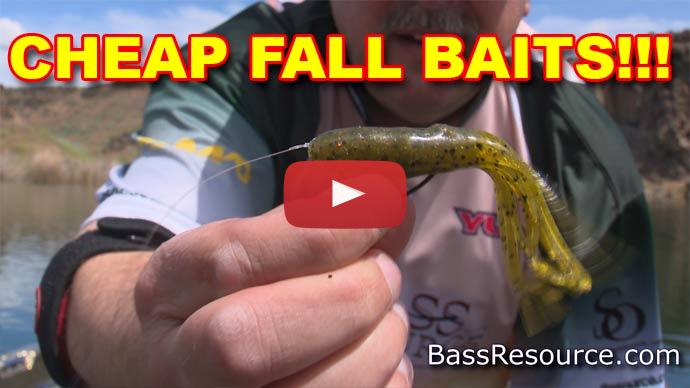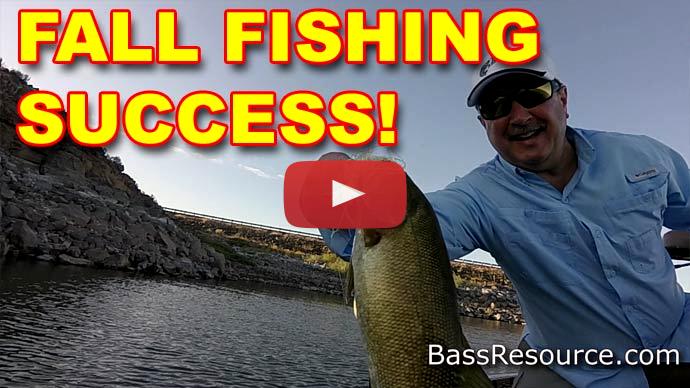Hey everyone, Mike McClellans Pro Pro here to talk fall jerkbait fishing. And, you know, to me, early on, I thought, you know, spring and fall were probably the two most productive times of the year to throw a jerkbait. But, you know, anymore a jerkbait is used pretty much all year round, but one thing about the fall and why a jerkbait is so effective is because of the migration route that baitfish start taking in the fall. I mean, when you get past the summer, when you get past a lot of the lakes that create thermoclines and that thermocline breaks, and the water becomes all the same in a lake, that's what usually gets the baitfish moving and going on their fall migration.
I mean, so often any lakes that we fish or even river systems we fish, a lot of the bait is gonna be in the main body of the lake during the summer months. They're gonna be hovering around the thermocline, or in a river system they're gonna be in those deeper cooler holes. But when you get to the fall and that water temperature all starts cooling down, and those baitfish start migrating, that's the perfect time to pull the jerkbait out again.
And when I say that, migrations of baits starts, you know, on the main lake, you'll start seeing bait that migrate into the creeks, the bigger creeks off of the main lake. When you start getting up into the rivers, you'll have a big migration of bait that just wants to go as far up that river system as they can in the fall. And one reason for that is because the oxygen level in the lake sometimes changes dramatically when that thermocline breaks down or when that water temperature first starts to really cool off. So those baitfish are really just trying to seek a more comfortable environment and the bass are gonna take advantage of that.
So once you see that fall migration start to happen, you really wanna be open-minded and not necessarily look to be fishing a specific type of cover, a specific type of structure, but you really wanna focus on the bait. I spend a lot of time in the fall, just running from creek to creek to creek until I find that creek that that migration is happening in, and then all you have to do is just zero in on fishing the bait itself.
And it's so much easier now than it used to be because we can truly look out in front of us with our Garmin LiveScope and see what depth those fish are at, what depth the shad are at. Forward-facing sonar is a huge deal, but side view and clear view, and even 2D sonar are gonna be really helpful in the fall. As I idle around and looking in these creeks, I'm just looking for baitfish on my 2D sonar, I'm looking for it on my side imaging, and I'm looking for it on my clear view. And once I find that creek or that river arm that has the most bait, that's when I'm gonna shut down and really get in to throw in jerkbaits.
And when you start talking about color choices and things of that nature, you know, my rule of thumb has always been, it's not about the water color specifically that is gonna dictate what color stick bait I throw. It's more about the condition of the day. The watercolor does factor into it, but it's more about the condition of the day, how hard the wind's blowing, how dark the skies are, how sunny the skies are.
So anytime I'm fishing, you know, really clear water on a day that the wind is fairly light, I'm gonna really stick to translucent colors. You know, something like ghosts minnow. Blue bandit is a fairly translucent color.
And baits that don't necessarily have a lot of opaque colors to them. The new Matte Shad is another good example of a bait that's fairly translucent.
And the reason for that is with the lighter winds, the fish just don't see the bait as well so they're more apt to eat it. It looks more natural to them.
Now, if you get situations where you get higher winds and a lot of chop on the water where the sun's deflected, that's when I'm gonna go to the more opaque colors, you know, even something like Midnight Blue or something like a Dirty Bone, something that's got a lot of flash power. Something that when you hit that bait, even though there's a lot of, you know, the water color's clear, but there's a lot of movement in the water, it's gonna just show up a lot better and the fish are gonna be able to find baits like that.
Then you start talking about maybe some of these wild colors. Delta Chrome, anytime the water color does get a little bit stained, I think the flash of Delta Chrome, the red head is gonna be a good bait to throw. And then a bait like this is one of those baits that even in dirty dingy off water conditions, you've got so many different color variations, a lot of flash that you can draw a lot of bites, but don't be afraid to throw these baits in a clear water situation as well.
Probably when I'm fishing a jerkbait a big key is gear ratio on my reel. I'm always gonna throw a 5:1 gear ratio reel. I'm gonna throw a jerk bait on a six and a half to seven foot Falcon rod of some kind. I really like the jerkbait rod. It's a six-foot eight-inch rod and allows me, you know, to throw that bait into tight places, around boat docks, around timber, things like that.
And another big key about throwing a jerkbait is typically gonna be line size. I am very, very much a fan of throwing a jerkbait on either Sunline Supernatural Monofilament, generally somewhere between 8 and 12 pound. And then if I'm not throwing the Sunline Supernatural Monofilament, I throw the Sunline FC Crank in that same range somewhere between 8 and 14-pound test.
And the reason that I vary my line size is to help achieve the depths that I want to achieve with this bait. The smaller diameter line or the smaller test that I throw the deeper I'm gonna be able to get this bait. So if I wanna hold this bait up in the water column, all I have to do is go up to a 10, 12, 14-pound test, and I can actually take away the depth diving ability of this bait and hold it up in the water column.
The biggest thing that I will say is I do not like to throw a jerkbait on a straight fluorocarbon line. The FC Crank is actually a fluorocarbon baseline, but it still has kind of a neutral buoyancy aspect in the water. So it's not gonna drag the bait down when you go into those pausing sessions with the bait.
Again, you know, there's really not a wrong jerkbait to throw. In the fall you get a lot of schooling action as well. So the Zero Minnow is something, and I'm definitely gonna keep in my arsenal in the fall time. You're gonna see those singles a lot of time, come up and blow up in a bait ball. And a lot of times, if you can get right in on top of them with the topwater, you'll catch them.
But if you just pay attention to the shad that are really working the surface and really start skipping and hopping, I mean, those are the ones that are being chased. Those are the ones that fish are really aggressively after and the McStick 110 and the McStick 115, both will be really effective to fish for those fish.
Again, I'm not so worried about, you know, the bait suspending that time of the year, I'm gonna be fishing the bait in a really fast manner. I'm just trying to get those fish that are starting to feed up for that winter to react to a bait.
So, one thing about it, you know, I kind of threw this Zero Minnow in as part of the jerkbait line, and it can definitely be fished as a jerkbait. It's a bait that you can just wind very slow right under the surface. But the true effective way to throw this is keeping that thing on the surface. And the big key to throwing this bait is when you first make your throw, you want to keep your rod at about ten or eleven o'clock. As you get that bait closer to you, you just actually want to follow it down with your rod tip, where you end up probably down in about the seven o'clock position. And you're going to keep that bait just hovering right there on the surface, throwing that V-Wake.
This is a McStick 115. Anytime I'm throwing this bait, like I said, I'm really not worried about, it's a floater diver, so I'm not worried about slowing my cadence down. I mean, I'm throwing it on the edge of grass, over flats, around bait balls. It's just one of those baits that you can cover a lot of water with. You can work it really fast. It's a real erratic bait. Floats, you know, when you stop it, so you really want to just keep it coming most of the time.
Another thing that I really like to keep in mind so often in the fall, these fish have been really, really pressured. And this is a bait that I really feel like comes into play based on the forage size. Probably one of the biggest things that I really pay attention to is, you know, when you're fishing a body of water and you start seeing a lot of shore minnows or real small threadfin shad, I really believe sometimes this 95 will get you bites it's when the 110 won't. So be sure and mix that little McStick 95 into your lineup and I promise you, you're gonna catch more fish on a jerkbait this fall than you ever have.
BassResource may receive a portion of revenues if you make a purchase using a link above.



